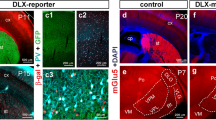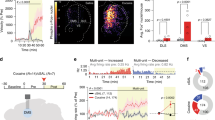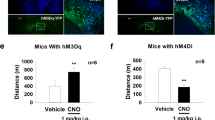Abstract
Dopaminergic neurons regulate and organize numerous important behavioral processes including motor activity. Consistently, manipulation of brain dopamine concentrations changes animal activity levels. Dopamine is synthesized by several neuronal populations in the brain. This study was carried out to directly test whether selective activation of dopamine neurons in the midbrain induces hyperactivity. A pharmacogenetic approach was used to activate midbrain dopamine neurons, and behavioral assays were conducted to determine the effects on mouse activity levels. Transgenic expression of the evolved hM3Dq receptor was achieved by infusing Creinducible AAV viral vectors into the midbrain of DAT-Cre mice. Neurons were excited by injecting the hM3Dq ligand clozapine-N-oxide (CNO). Mouse locomotor activity was measured in an open field. The results showed that CNO selectively activated midbrain dopaminergic neurons and induced hyperactivity in a dose-dependent manner, supporting the idea that these neurons play an important role in regulating motor activity.
Similar content being viewed by others
References
Seeman P, Van Tol HH. Dopamine receptor pharmacology. Trends Pharmacol Sci 1994, 15: 264–270.
Bjorklund A, Dunnett SB. Dopamine neuron systems in the brain: an update. Trends Neurosci 2007, 30: 194–202.
Schultz W. Behavioral dopamine signals. Trends Neurosci 2007, 30: 203–210.
Xu M, Hu XT, Cooper DC, Moratalla R, Graybiel AM, White FJ, et al. Elimination of cocaine-induced hyperactivity and dopamine-mediated neurophysiological effects in dopamine D1 receptor mutant mice. Cell 1994, 79: 945–955.
Giros B, Jaber M, Jones SR, Wightman RM, Caron MG. Hyperlocomotion and indifference to cocaine and amphetamine in mice lacking the dopamine transporter. Nature 1996, 379: 606–612.
Gainetdinov RR, Wetsel WC, Jones SR, Levin ED, Jaber M, Caron MG. Role of serotonin in the paradoxical calming effect of psychostimulants on hyperactivity. Science 1999, 283: 397–401.
Emilien G, Maloteaux JM, Geurts M, Hoogenberg K, Cragg S. Dopamine receptors—physiological understanding to therapeutic intervention potential. Pharmacol Ther 1999, 84: 133–156.
Olanow CW, Tatton WG. Etiology and pathogenesis of Parkinson’s disease. Annu Rev Neurosci 1999, 22: 123–144.
Armbruster BN, Li X, Pausch MH, Herlitze S, Roth BL. Evolving the lock to fit the key to create a family of G proteincoupled receptors potently activated by an inert ligand. Proc Natl Acad Sci U S A 2007, 104: 5163–5168.
Alexander GM, Rogan SC, Abbas AI, Armbruster BN, Pei Y, Allen JA, et al. Remote control of neuronal activity in transgenic mice expressing evolved G protein-coupled receptors. Neuron 2009, 63: 27–39.
Dong S, Rogan SC, Roth BL. Directed molecular evolution of DREADDs: a generic approach to creating next-generation RASSLs. Nat Protoc 2010, 5: 561–573.
Zhang F, Gradinaru V, Adamantidis AR, Durand R, Airan RD, de Lecea L, et al. Optogenetic interrogation of neural circuits: technology for probing mammalian brain structures. Nat Protoc 2010, 5: 439–456.
Duan D, Yue Y, Engelhardt JF. Expanding AAV packaging capacity with trans-splicing or overlapping vectors: a quantitative comparison. Mol Ther 2001, 4: 383–391.
Zhuang X, Oosting RS, Jones SR, Gainetdinov RR, Miller GW, Caron MG, et al. Hyperactivity and impaired response habituation in hyperdopaminergic mice. Proc Natl Acad Sci U S A 2001, 98: 1982–1987.
Gong R, Ding C, Hu J, Lu Y, Liu F, Mann E, et al. Role for the membrane receptor guanylyl cyclase-C in attention deficiency and hyperactive behavior. Science 2011, 333: 1642–1646.
Volkow ND, Wang GJ, Kollins SH, Wigal TL, Newcorn JH, Telang F, et al. Evaluating dopamine reward pathway in ADHD: clinical implications. JAMA 2009, 302: 1084–1091.
Russell VA. Neurobiology of animal models of attentiondeficit hyperactivity disorder. J Neurosci Methods 2007, 161: 185–198.
Sagvolden T, Russell VA, Aase H, Johansen EB, Farshbaf M. Rodent models of attention-deficit/hyperactivity disorder. Biol Psychiatry 2005, 57: 1239–1247.
Hess EJ, Collins KA, Wilson MC. Mouse model of hyperkinesis implicates SNAP-25 in behavioral regulation. J Neurosci 1996, 16: 3104–3111.
Author information
Authors and Affiliations
Corresponding author
Rights and permissions
About this article
Cite this article
Wang, S., Tan, Y., Zhang, JE. et al. Pharmacogenetic activation of midbrain dopaminergic neurons induces hyperactivity. Neurosci. Bull. 29, 517–524 (2013). https://doi.org/10.1007/s12264-013-1327-x
Received:
Accepted:
Published:
Issue Date:
DOI: https://doi.org/10.1007/s12264-013-1327-x




